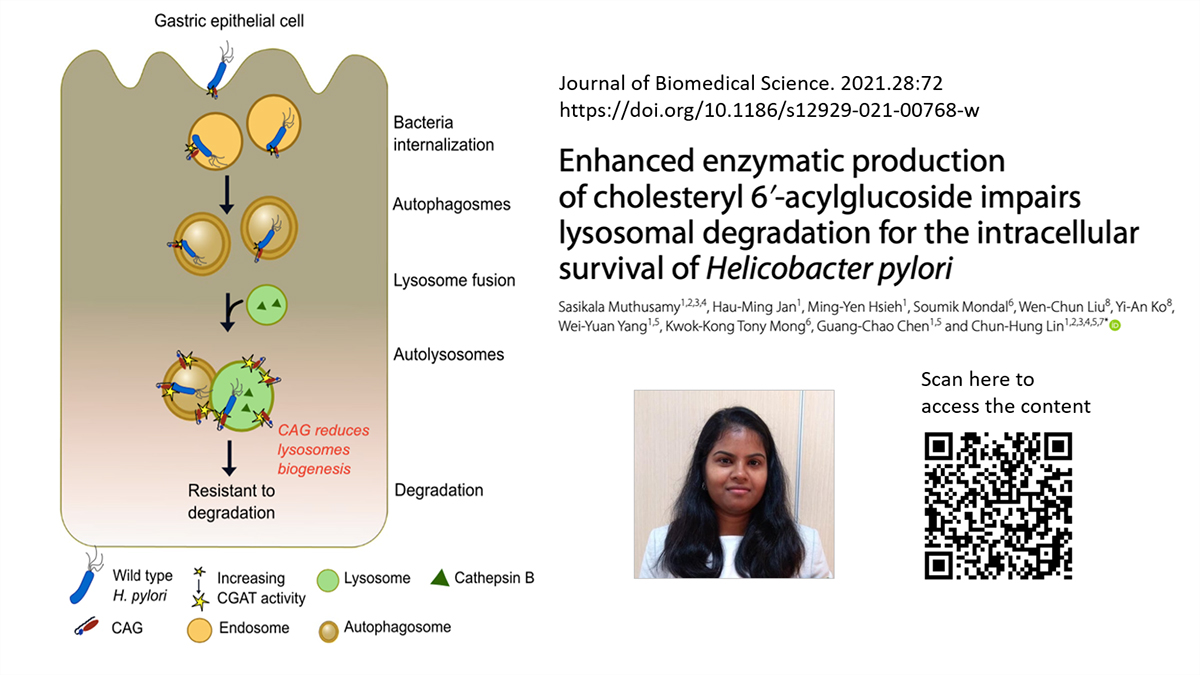
 中央研究院 生物化學研究所
中央研究院 生物化學研究所
Background: During autophagy defense against invading microbes, certain lipid types are indispensable for generating specialized membrane-bound organelles. The lipid composition of autophagosomes remains obscure, as does the issue of how specific lipids and lipid-associated enzymes participate in autophagosome formation and maturation. Helicobacter pylori is auxotrophic for cholesterol and converts cholesterol to cholesteryl glucoside derivatives, including cholesteryl 6'-O-acyl-α-D-glucoside (CAG). We investigated how CAG and its biosynthetic acyltransferase assist H. pylori to escape host-cell autophagy.
Methods: We applied a metabolite-tagging method to obtain fluorophore-containing cholesteryl glucosides that were utilized to understand their intracellular locations. H. pylori 26695 and a cholesteryl glucosyltransferase (CGT)-deletion mutant (ΔCGT) were used as the standard strain and the negative control that contains no cholesterol-derived metabolites, respectively. Bacterial internalization and several autophagy-related assays were conducted to unravel the possible mechanism that H. pylori develops to hijack the host-cell autophagy response. Subcellular fractions of H. pylori-infected AGS cells were obtained and measured for the acyltransferase activity.
Results: The imaging studies of fluorophore-labeled cholesteryl glucosides pinpointed their intracellular localization in AGS cells. The result indicated that CAG enhances the internalization of H. pylori in AGS cells. Particularly, CAG, instead of CG and CPG, is able to augment the autophagy response induced by H. pylori. How CAG participates in the autophagy process is multifaceted. CAG was found to intervene in the degradation of autophagosomes and reduce lysosomal biogenesis, supporting the idea that intracellular H. pylori is harbored by autophago-lysosomes in favor of the bacterial survival. Furthermore, we performed the enzyme activity assay of subcellular fractions of H. pylori-infected AGS cells. The analysis showed that the acyltransferase is mainly distributed in autophago-lysosomal compartments.
Conclusions: Our results support the idea that the acyltransferase is mainly distributed in the subcellular compartment consisting of autophagosomes, late endosomes, and lysosomes, in which the acidic environment is beneficial for the maximal acyltransferase activity. The resulting elevated level of CAG can facilitate bacterial internalization, interfere with the autophagy flux, and causes reduced lysosomal biogenesis.
Keywords: Autophagosomes; Autophagy; Autophagy flux; Bacterial internalization; Cholesteryl glucosides; H. pylori; Lipid-raft clustering; Lysosome biogenesis; Lysosomes.
